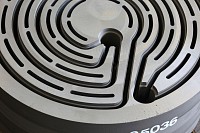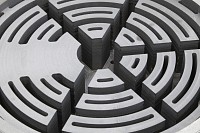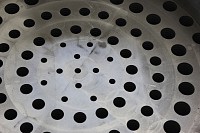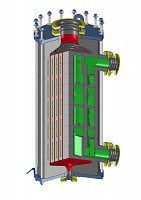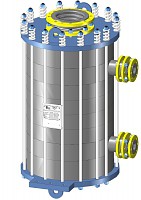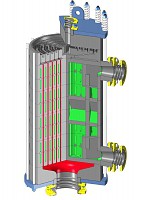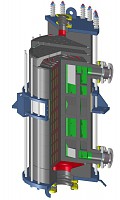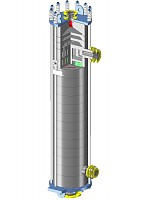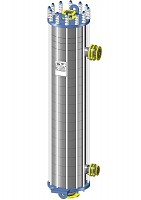Annular groove graphite evaporators and reboilers
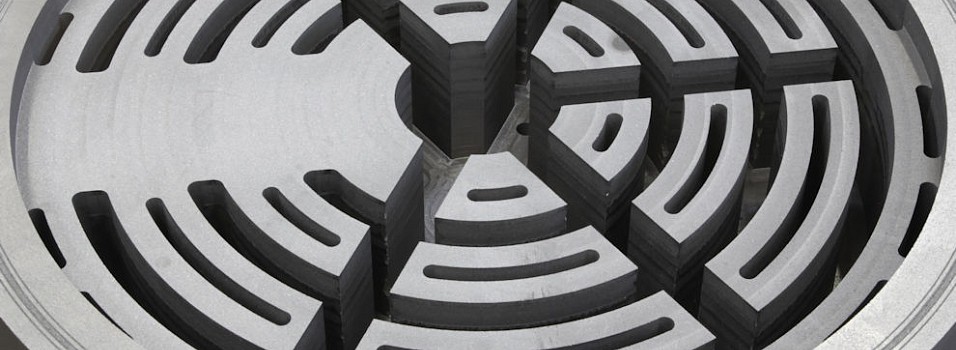
With their specific design our annular groove graphite evaporators and reboilers are especially adapted to the evaporation of highly corrosive chemicals. Annular groove evaporators & reboilers turn the liquid form of a chemical substance such as water or a solvent into its gaseous-form. It is often used to concentrate solutions by evaporation of the solvent. We offer annular groove falling film evaporators, as well as natural and forced circulation reboilers. Annular groove evaporators and reboilers transfer heat from condensing steam or thermal oil on service side to a boiling liquid on process side. Graphite discs are machined to create annular grooves on service side and large banana shaped channels on the process side. Heat is transferred by conduction through the impervious graphite left between the process and the service channels. Annular groove graphite evaporators consist in a stack of discs that are fused together.
Snapshots
Details of an annular groove graphite reboiler
GAB Neumann’s reboilers consist of series of concentric annular grooves and channels that are machined in graphite discs. In this very case the service side fluid flows in three parallel grooves.
Details of an annular groove graphite falling film evaporator
GAB Neumann’s falling film evaporators consist in a liquid distribution and an evaporation section. Here is the evaporation section.
Details of an annular groove graphite falling film evaporator
GAB Neumann’s falling film evaporators consist in a liquid distribution and an evaporation section. Here is a liquid distribution plate.
3D renderings
Cross-sectional view of a UB type annular groove reboiler
GAB Neumann's UB type reboilers consist in a stack of impervious graphite discs, with straight channels on process side and annular grooves on service side, that are fused together.
Annular groove UB type reboiler
GAB Neumann's UB type reboilers consist in a stack of impervious graphite discs, with straight channels on process side and annular grooves on service side, that are fused together.
Cross-sectional view of a FB type annular groove falling film evaporator
This specific annular groove falling film evaporator is equipped with a liquid distribution area with overflow crows.
Cross-sectional view of a FB type annular groove falling film evaporator
This specific annular groove falling film evaporator is equipped with liquid distribution plates.
Cross-sectional view of a FB type annular groove falling film evaporator
The FB type annular groove falling film evaporator includes a liquid distribution plate in its upper section as well as a product evaporation area in its lower section.
Annular groove FB type falling film evaporator
GAB Neumann's FB type reboilers consist in a stack of impervious graphite discs, with straight channels on process side and annular grooves on service side, that are fused together.
Materials:
- Impervious graphite: GAB GPX1, GPX1T or GPX2
- Pressure plates and flanges: carbon steel or stainless steel (optional)
- Tie rods, nuts, bolts, washers, springs: stainless steel
Design:
- Totally modular design: number of discs, size of discs and number of passes can be adjusted.
- Graphite discs with annular groove (spiral)
- Maximum disc diameter: 900 mm (36")
- Different groove widths possible
- Graphite nozzles on product and utility sides
- Thermal expansion compensation ensured by tie rods and helical springs
- Carbon-fiber reinforcement (optional)
Key features:
- Design pressure: -1 barg (full vacuum) to +10 barg (145 psig)
- Design temperature: -60 to +200°C (-76 to 392°F)
- Heat transfer area: up to 55 m² (592 ft²)
- Design: according to European Pressure Equipment Directive 2014/68/EU (PED) or ASME Code
Key benefits
- Outstanding corrosion resistance
- Superior heat transfer performance thanks to adjustable cross sections on both sides that guaranty a high level of turbulence
- Gasket free design (fused discs)
- Resin free surfaces (impregnation before machining)
- Self-cleaning design prevents fouling and clogging
- High operational safety
- Highly reliable equipment therefore low cost of ownership and low maintenance cost
- Compact and robust design
- Short lead time
- Long lifetime
Optional features:
- Sight glass
- Carbon fiber reinforcement
- Cleaning in place
Main applications:
- Liquid evaporation
- Sump reboiling
Technical documentation
Evaporators & reboilers
The process of evaporation is used widely in the chemical process industry for a variety of purposes. These include the concentration of solutions, revaporization of liquefied gases, refrigeration applications, and generation of pure and mixed vapors for process applications. The term evaporators is usually reserved for the first of these applications, namely the vaporization of the solvent from a solution in order to concentrate the solution. Evaporators may be classified into falling film evaporators (in which evaporation takes place from the film interface with no nucleate boiling at the wall), natural or forced circulation evaporators or reboilers (in which wall nucleate boiling occurs over part or all of the heat transfer surface), flash evaporators, and direct contact evaporators.
Falling film evaporators
In falling film evaporators, the liquid product enters at the top of the evaporator. In the head, the product is evenly distributed into the heating holes. The liquid forms a thin film on the walls, flows downwards at boiling temperature, and partially evaporates. In most cases, steam is used for heating the evaporator. Thermal oil can also be used. The separation of the concentrated product from its vapor takes place in the lower part of the heat exchanger in the vapor/liquid separator.
Falling film evaporators versus flooded evaporators
Falling film evaporators have a number of advantages over their flooded evaporator counterparts. They require a lower amount of fluid as the entire process side doesn't need to be filled with liquid as a thin film is used to cover the surface. Falling film evaporators also show improved heat transfer characteristics over their flooded counterparts, particularly in cases with low heat flux. The residence time in falling film evaporators is extremely short thus creating a gentle evaporation especially under vacuum and subsequently preserving the quality of the product. Process control and automation is also easier in falling Film Evaporators. Thanks to their lower amount of fluid falling film evaporators react faster to changes in energy supply, vacuum, feed quantities, or concentrations.
However the fluid distribution for falling film evaporators may be challenging. The performance might be affected if the fluid is not evenly distributed over the surface. In addition due to the intimate contact of the liquid with the heating surface, falling film evaporators are sensitive to fouling from precipitating solids. The fluid velocity, typically low at the inlet is usually not sufficient to perform an effective self-cleaning. Falling film evaporators are therefore preferably used for the evaporation of clean, non-precipitating liquids.
Natural circulation evaporators
Natural circulation evaporation is based upon natural convection currents. Circulation through convection is achieved through bubble formation. Bubbles have a lower density and rise therefore through the liquid to promote upward lift in the evaporation vessel. Thermosyphon reboilers do not require pumping of the column bottoms liquid into the reboiler. Natural circulation is obtained by using the density difference between the reboiler inlet liquid and the reboiler outlet liquid-vapor mixture to provide sufficient liquid head to deliver the fluid into the reboiler.
Physically natural circulation evaporators are usually rather short. Removing of the circulation pump reduces the operating costs, however due to characteristics of the system natural circulation evaporators have a long residence time and low flow rates, making their uses more limited than forced circulation evaporators. The most common application of natural circulation evaporators is as reboiler for distillation columns.
Forced circulation evaporators
In natural circulation evaporators, the liquid enters with low velocity and generally, the heat transfer coefficients are quite low. This is particularily true with viscous liquids. So, whenever we are dealing with a concentration of highly viscous and scale forming solutions there is no alternative but to use forced circulation evaporators. By increasing the velocity of the liquid flow through the evaporator heat transfer coefficients increases significantly. the high liquid velocity which is resulting from the pumps prevents the scale formation on heating surfaces.
Reboilers
Reboilers are heat exchangers typically used to provide heat to the bottom of distillation columns. They boil the liquid from the bottom of a distillation column to generate vapors which are returned to the column to drive the distillation separation. The heat supplied to the column by the reboiler at the bottom of the column is removed by the condenser at the top of the column.
Proper reboiler operation is vital to effective distillation. In a typical classical distillation column, all the vapor driving the separation comes from the reboiler. The reboiler receives a liquid stream from the column bottom and may partially or completely vaporize that stream. Steam usually provides the heat required for the vaporization.
Forced circulation reboilers
A forced circulation reboiler uses a pump to circulate the liquid through the reboiler. This is especially useful if the reboiler must be located far from the flash tank or if the liquid is viscous or temperature sensitive (subject to crystallization, polymerization, or degradation) by contact with high temperature heat transfer walls. High liquid recirculation rates are used to increase the heat transfer film coefficient on process side, reduce wall temperatures, thereby reducing polymerization on the wall and associated fouling.
Flash evaporators
In flash evaporation, the liquid is preheated at pressure and then flashed through a restriction into a vessel at lower pressure where vapor is formed in the process of restoring the liquid to its saturation temperature.
Direct contact evaporators
In this type of evaporator, a hot gas is injected into a pool of liquid and causes it to evaporate, the vapor being carried away with the efflux gas. Such evaporators are relatively cheap and useful for the concentration of corrosive fluids, viscous liquids and slurries which may be difficult to handle in more conventional heat exchanger. Stripping columns are direct contact evaporators.
GAB Neumann’s annular groove graphite falling film evaporators & reboilers – FB and UB series
Our extended and highly customizable falling film evaporator and natural or forced circulation reboiler portfolio enables us to provide particularly adapted solutions to the vaporization of ultra-corrosive liquids. All our falling film evaporators' and natural or forced circulation reboilers’ designs are totally modular to best fit with individual process specification. The number and size of dics, the number, and the width of annular grooves can be adapted to best meet the velocities, pressure drops, and heat transfer requirements.
They can be fitted with all kinds of optional features such as carbon fiber reinforcement, sight glasses, GMP-compliant design, or demountable headers and distributors for easy mechanical cleaning.
All our graphite falling film evaporators and natural or forced circulation reboilers are machined after phenolic resin impregnation thus guarantying a heat transfer surface totally free of resin and ensuring therefore the highest possible heat transfer rate.
Annular groove falling film evaporators - FB Series
GAB Neumann’s annular groove graphite falling film evaporators are vertically mounted. Annular groove graphite falling film evaporators consist in a stack of discs, with straight channels on process side and annular grooves on service side, that are fused together. They include a liquid distribution plate in their upper section as well as a product evaporation area in their lower section. GAB Neumann’s annular groove graphite falling film evaporators are designed to distribute the liquid to be evaporated into the grooves, to ensure the proper creation of the film at the surface of the grooves. On the service side steam or thermal oil can be used as a heating media.
Annular groove reboilers - UB Series
GAB Neumann’s annular groove graphite reboilers are vertically mounted. They are adapted to natural and forced circulation evaporation. Annular groove graphite reboilers consist in a stack of discs, with straight channels on process side and annular grooves on service side, that are fused together. They include a product evaporation section with straight channels. On the service side steam or thermal oil can be used as a heating media.
Industrial processes:
- Crop protection
- Fumed silica
- Silicones
- Titanium dioxide
- Fine chemicals
- Active pharmaceutical ingredients
- Copper electrolysis
- Epichlorohydrin
- Vinyl chloride monomer
- Fire retardants
- Flavors and fragrances
- Vitamins
- Isocyanates
- Viscose
- Polycarbonate
- Treatment, purification and concentration of spent acids
- and many more…
GAB Neumann GmbH
Alemannenstrasse 29
79689 Maulburg
Germany
GAB Neumann GmbH | Alemannenstrasse 29 | D-79689 Maulburg | Phone +49 (7622) 6751 0 | Fax +49 (7622) 6751 20 | E-Mail info@gab-neumann.de | www.gab-neumann.com


